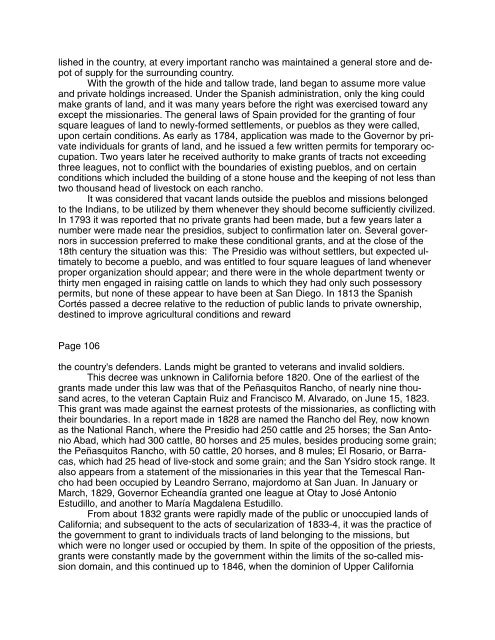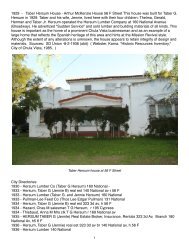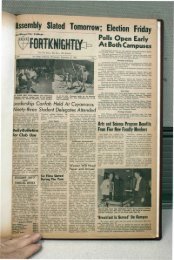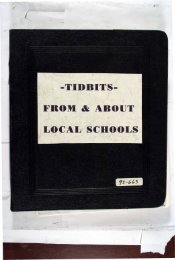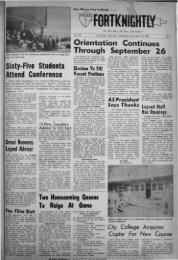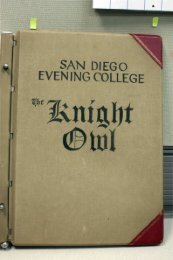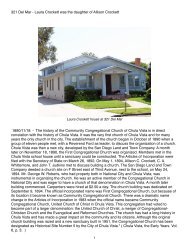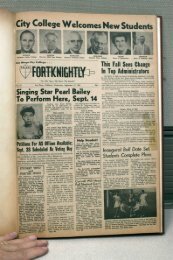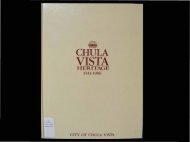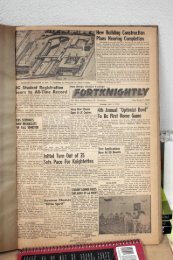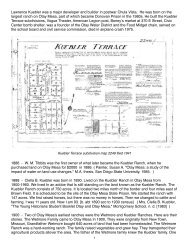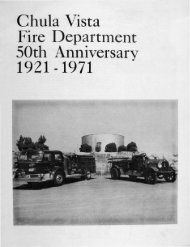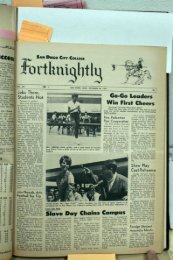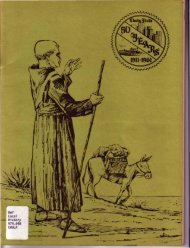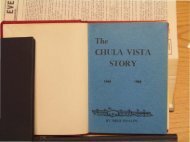doc241 - Schoenherr Home Page in Sunny Chula Vista
doc241 - Schoenherr Home Page in Sunny Chula Vista
doc241 - Schoenherr Home Page in Sunny Chula Vista
You also want an ePaper? Increase the reach of your titles
YUMPU automatically turns print PDFs into web optimized ePapers that Google loves.
lished <strong>in</strong> the country, at every important rancho was ma<strong>in</strong>ta<strong>in</strong>ed a general store and depot<br />
of supply for the surround<strong>in</strong>g country.<br />
With the growth of the hide and tallow trade, land began to assume more value<br />
and private hold<strong>in</strong>gs <strong>in</strong>creased. Under the Spanish adm<strong>in</strong>istration, only the k<strong>in</strong>g could<br />
make grants of land, and it was many years before the right was exercised toward any<br />
except the missionaries. The general laws of Spa<strong>in</strong> provided for the grant<strong>in</strong>g of four<br />
square leagues of land to newly-formed settlements, or pueblos as they were called,<br />
upon certa<strong>in</strong> conditions. As early as 1784, application was made to the Governor by private<br />
<strong>in</strong>dividuals for grants of land, and he issued a few written permits for temporary occupation.<br />
Two years later he received authority to make grants of tracts not exceed<strong>in</strong>g<br />
three leagues, not to conflict with the boundaries of exist<strong>in</strong>g pueblos, and on certa<strong>in</strong><br />
conditions which <strong>in</strong>cluded the build<strong>in</strong>g of a stone house and the keep<strong>in</strong>g of not less than<br />
two thousand head of livestock on each rancho.<br />
It was considered that vacant lands outside the pueblos and missions belonged<br />
to the Indians, to be utilized by them whenever they should become sufficiently civilized.<br />
In 1793 it was reported that no private grants had been made, but a few years later a<br />
number were made near the presidios, subject to confirmation later on. Several governors<br />
<strong>in</strong> succession preferred to make these conditional grants, and at the close of the<br />
18th century the situation was this: The Presidio was without settlers, but expected ultimately<br />
to become a pueblo, and was entitled to four square leagues of land whenever<br />
proper organization should appear; and there were <strong>in</strong> the whole department twenty or<br />
thirty men engaged <strong>in</strong> rais<strong>in</strong>g cattle on lands to which they had only such possessory<br />
permits, but none of these appear to have been at San Diego. In 1813 the Spanish<br />
Cortés passed a decree relative to the reduction of public lands to private ownership,<br />
dest<strong>in</strong>ed to improve agricultural conditions and reward<br />
<strong>Page</strong> 106<br />
the country's defenders. Lands might be granted to veterans and <strong>in</strong>valid soldiers.<br />
This decree was unknown <strong>in</strong> California before 1820. One of the earliest of the<br />
grants made under this law was that of the Peñasquitos Rancho, of nearly n<strong>in</strong>e thousand<br />
acres, to the veteran Capta<strong>in</strong> Ruiz and Francisco M. Alvarado, on June 15, 1823.<br />
This grant was made aga<strong>in</strong>st the earnest protests of the missionaries, as conflict<strong>in</strong>g with<br />
their boundaries. In a report made <strong>in</strong> 1828 are named the Rancho del Rey, now known<br />
as the National Ranch, where the Presidio had 250 cattle and 25 horses; the San Antonio<br />
Abad, which had 300 cattle, 80 horses and 25 mules, besides produc<strong>in</strong>g some gra<strong>in</strong>;<br />
the Peñasquitos Rancho, with 50 cattle, 20 horses, and 8 mules; El Rosario, or Barracas,<br />
which had 25 head of live-stock and some gra<strong>in</strong>; and the San Ysidro stock range. It<br />
also appears from a statement of the missionaries <strong>in</strong> this year that the Temescal Rancho<br />
had been occupied by Leandro Serrano, majordomo at San Juan. In January or<br />
March, 1829, Governor Echeandía granted one league at Otay to José Antonio<br />
Estudillo, and another to María Magdalena Estudillo.<br />
From about 1832 grants were rapidly made of the public or unoccupied lands of<br />
California; and subsequent to the acts of secularization of 1833-4, it was the practice of<br />
the government to grant to <strong>in</strong>dividuals tracts of land belong<strong>in</strong>g to the missions, but<br />
which were no longer used or occupied by them. In spite of the opposition of the priests,<br />
grants were constantly made by the government with<strong>in</strong> the limits of the so-called mission<br />
doma<strong>in</strong>, and this cont<strong>in</strong>ued up to 1846, when the dom<strong>in</strong>ion of Upper California


